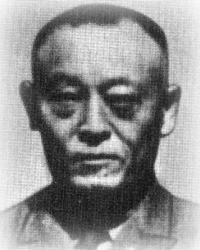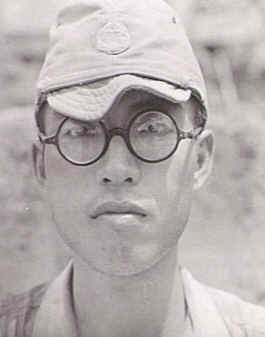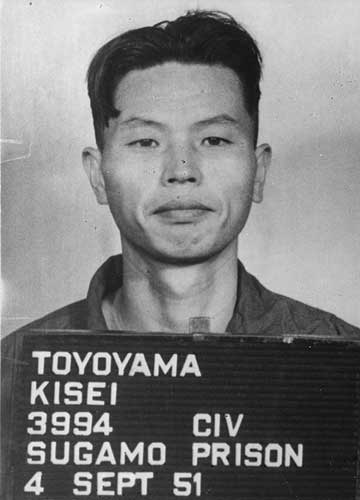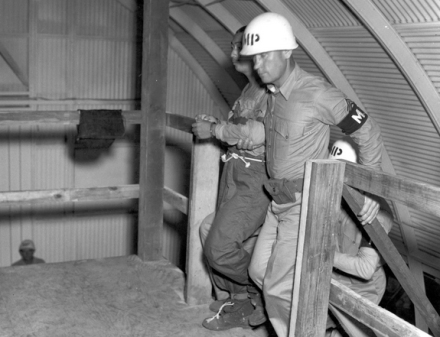Homma was born on Sado Island, in the Sea of Japan off of Niigata Prefecture. He graduated from the 14th class of the Imperial Japanese Army Academy in 1907, and from the 27th class of the Army Staff College in 1915. Homma had a deep respect for and some understanding of the West, having spent eight years as a military attaché in the United Kingdom, including serving in combat in World War I in France in 1918 with the British Expeditionary Force.From 1930-1932, Homma was again sent as a military attaché to the United Kingdom, where his proficiency in the English language was useful. He was also assigned to be part of the Japanese delegation to the Geneva Disarmament Conference in 1932 and served with the Press Section of the Army Ministry from 1932-1933. He was given a field command again, as commander of the IJA 1st Infantry Regiment from 1933–1935, and was promoted to command the IJA 32nd Infantry Brigade from 1935-1936.In 1937, Homma was appointed aide-de-camp to Prince Chichibu, a brother of Emperor Shōwa. With him, he made a diplomatic tour in Europe which ended in Germany. There he attended the Nuremberg rally and met Adolf Hitler, with whom the prince tried to boost relations, following the Anti-Comintern Pact of 1936.With the start of the Second Sino-Japanese War, Homma was appointed commander of the IJA 27th Division in China from 1938-1940 and directed the blockade of the foreign concessions in Tientsin, where he led the negotiations with the British. After the fall of Nanking, he declared publicly that "unless peace is achieved immediately it will be disastrous". Homma was removed from his position at the front lines, and re-assigned to become commander in chief of the Taiwan Army District from 1940-1941. He was promoted to lieutenant general in July 1938.With the start of the Pacific War, Homma was named commander of the 43,110 man IJA 14th Army and tasked with the invasion of the Philippines. He ordered his troops to treat the Filipinos not as enemies but as friends, and respect their customs and religion. In one instance, on his approach to Manila, Homma stopped his columns and ordered the men to clean up and tighten formations, knowing that unkempt soldiers are more likely to loot and rape.This liberal approach towards Filipino civilians earned him the enmity of his superior, General Count Hisaichi Terauchi, commander of the Southern Army, who sent adverse reports about Homma to Tokyo from his headquarters in Saigon. There was also a growing subversion within Homma's command by a small group of insubordinates, under the influence of Colonel Tsuji Masanobu. In Homma's name, they sent out secret orders against his policies, including ordering the execution of Filipino Chief Justice Jose Abad Santos and attempted execution of former Speaker of the House of Representatives Manuel Roxas, which Homma found out about in time to stop.Homma failed to give credence to the possibility that a retreat into Bataan Peninsula by Filipino-American forces might succeed in upsetting the Japanese timetable. By the time he recognized his mistake, his best infantry division had been replaced by a poorly trained reserve brigade, greatly weakening his assault force. Rather than waste his men in furious frontal assaults, he tried to outmaneuver the American forces. This brought criticism from superiors who believed he had been “contaminated” by Western ideas about conserving the lives of his men.Worried about the stalled offensive in Luzon, Emperor Shōwa pressed Army Chief of Staff Hajime Sugiyama twice on January 1942 to increase troop strength and launch a quick knockout on Bataan. Following these orders, Sugiyama put pressure on Homma to renew his attacks. The resulting Battle of Bataan commencing in January 1942 was one of the most intense in the campaign. However, the deteriorating relationship between Homma and Sugiyama led to the removal of Homma from command shortly after the fall of Corregidor, and he was thereafter commander of the 14th Army in name only.The Imperial General Headquarters regarded Homma as not aggressive enough in war (resulting in the high cost and long delay in securing the American and Filipino forces' surrender), and too lenient with the Filipino people in peace, and he was subsequently forced into retirement, in August 1943. Homma retired from the military and lived in semi-seclusion in Japan until the end of the war. Homma was convicted by the U.S. military tribunal for war crimes in the Philippines, including the Bataan Death March, and the atrocities at O'Donnell and Cabanatuan which followed. Homma's chief defense counsel, John H. Skeen Jr., stated that in his opinion it was a "highly irregular trial, conducted in an atmosphere that left no doubt as to what the ultimate outcome would be." Associate Justice Frank Murphy of the U.S. Supreme Court protested the verdict, stating: "Either we conduct such a trial as this in the noble spirit and atmosphere of our Constitution or we abandon all pretense to justice, let the ages slip away and descend to the level of revengeful blood purges."Homma's wife appealed to General MacArthur to spare his life; her pleas were denied, though according to William Manchester in American Caesar, he ordered Homma shot, rather than sent to the gallows, the latter being considered the greater dishonor amongst military men. Homma was executed by firing squad by the Filipino and American forces on 3 April 1946 outside Manila.
General Tomoyuki Yamashita ( Yamashita Tomoyuki, 8 November 1885 - 23 February 1946) was a general of the Japanese Imperial Army during World War II. He was most famous for conquering the British colonies of Malaya and Singapore, earning the nickname "The Tiger of Malaya".

Yamashita was born the son of a local doctor in Osugi village, in what is now part of Ōtoyo village, Kōchi prefecture, Shikoku. He attended military preparatory schools in his youth. After graduating from the 18th class of the Imperial Japanese Army Academy in 1905, Yamashita joined the Imperial Japanese Army in 1906 and fought against the Germans in Shantung, China in 1914. He attended the 28th class of the Army War College, graduating sixth in his class in 1916. He married Hisako Nagayama, the daughter of retired General Nagayama in 1916. Yamashita became an expert on Germany, serving as assistant military attaché at Bern, Switzerland and Berlin Germany from 1919-1922.On his return to Japan in 1922, Yamashita served in the Imperial Headquarters and the Staff College. While posted to the Imperial Japanese Army General Staff, Yamashita unsuccessfully promoted a military reduction plan. Despite his ability, Yamashita fell into disfavor as a result of his involvement with adverse political factions within the Japanese military. As a leading member of the "Imperial Way" group, he became a rival to Hideki Tojo and other members of the "Control Faction".In 1928, Yamashita was posted to Vienna, Austria as the military attache. In 1930, Colonel Yamashita was given command of the 3rd Imperial Infantry Regiment, one of the strongest in the Japanese armyAfter the February 26 Incident of 1936, he also fell into disfavor with Emperor Hirohito due to his appeal for leniency toward the rebel officers involved in the attempted coup. On 6 November 1941, Yamashita was put in command of the Twenty-Fifth Army. On 8 December, he launched an invasion of Malaya, from bases in French Indochina. In the campaign, which concluded with the fall of Singapore on 15 February 1942, Yamashita's 30,000 front-line soldiers captured 130,000 British, Indian and Australian troops, the largest surrender of British-led personnel in history. He became known as the "Tiger of Malaya".The campaign and the subsequent Japanese occupation of Singapore included war crimes committed against captive Allied personnel and civilians, such as the Alexandra Hospital and Sook Ching Massacres. Yamashita's culpability for these events remains a matter of controversy, as some argued that he had failed to prevent them. However, Yamashita had the officer who instigated the hospital massacre and some soldiers caught looting executed for these acts, and he personally apologised to the surviving patients. On 17 July 1942, Yamashita was reassigned from Singapore to far-away Manchukuo, again having been given a post in commanding the Japanese First Army, and was effectively sidelined for a major part of the Pacific War.It is thought that Prime Minister Hideki Tōjō was responsible for his banishment, taking advantage of Yamashita's gaffe during a speech made to Singaporean civilian leaders in early 1942, when he referred to the local populace as "citizens of the Empire of Japan". This was considered embarrassing for the Japanese government, who officially did not consider the residents of occupied territories to have the rights or privileges of Japanese citizenship. In 1944, when the war situation was critical for Japan, Yamashita assumed the command of the Fourteenth Area Army to defend the Philippines on 10 October. The U.S. Army landed on Leyte on 20 October, only ten days after Yamashita's arrival at Manila. On 6 January 1945 the Sixth U.S. Army landed at Lingayen Gulf in Luzon.Yamashita commanded approximately 262,000 troops in three defensive groups. He tried to rebuild his army but was forced to retreat from Manila to the mountains of northern Luzon. Yamashita ordered all troops, except those tasked with security, out of the city.Almost immediately, Rear Admiral Sanji Iwabuchi re-occupied Manila with 16,000 sailors, with the intent of destroying all port facilities and naval storehouses. Once there, Iwabuchi took command of the 3,750 Army security troops, and against Yamashita's specific order, turned the city into a battlefield.The actions of the Japanese garrison resulted in the deaths of more than 100,000 Filipino civilians, in what would be later known as the Manila Massacre, during the fierce street fighting for the capital which raged from February 4 to March 3. The court found Yamashita guilty as charged and sentenced him to death. Clarke appealed the sentence to MacArthur, who upheld it. He then appealed to the Philippine Supreme Court and the United States Supreme Court, both of which declined to review the verdict. As a consequence, Yamashita was executed on 23 February 1946.
Akira Mutō ( Mutō Akira, 15 December 1892 - 23 December 1948) was a general in the Imperial Japanese Army during World War II.

Mutō was a native of Kumamoto prefecture, and a graduate of the 25th class of the Imperial Japanese Army Academy in 1913. He graduated from the 32nd class of the Army Staff College in 1920. Mutō was assigned as a military attaché to Germany from 1923-1926. On his return to Japan, he served in various administrative and staff positions within the Imperial Army General Staff Office.Mutō was on the strategic planning staff of the General Staff Office in 1935, and was chief of the military intelligence section of the Kwangtung Army at the time of the Marco Polo Bridge Incident. He is believed to have been one of the planners behind the incident which sparked the Second Sino-Japanese War.[1][2] Promoted to Vice Chief of Staff of the Japanese Central China Area Army, Mutō was in China for many of the initial campaigns of the conflict, and was later charged with having led troops during the worst excesses of the Nanjing Massacre.Mutō was recalled to Japan in 1939, promoted to major general in 1939, and served on the Military Affairs Bureau of the Ministry of War.Promoted to lieutenant general just prior to the start of the Pacific War, Mutō served as director of the Military Affairs Bureau at the time of the attack on Pearl Harbor. He was assigned command of the Second Imperial Guards Division at Singapore in April 1942. He was later assigned to command Japanese forces on Sumatrain Japanese -occupied Netherlands East Indies from June 1944, and was transferred to the Philippines in October 1944, where he was appointed chief of staff of the Japanese Fourteenth Area Army under General Tomoyuki Yamashita.Acting insubordinately, he refused Yamashita's orders to abandon Manila after the landings of Allied forces on Luzon, and during the resulting Battle of Manila was accused of having conducted a campaign of slaughter, torture and other atrocities against the Filipino civilian population, prisoners of war and civilian internees.After the surrender of Japan, Mutō was arrested by the American occupation authorities and charged with war crimes before the International Military Tribunal for the Far East. He was convicted for atrocities against civilians and prisoners of war in both China and the Philippines, and was executed by hanging on 23 December 1948.
Heitarō Kimura ( Kimura Heitarō (sometimes Kimura Hyōtarō), 28 September 1888 - 23 December 1948) was a general in the Imperial Japanese Army.

Kimura was born in Saitama prefecture, north of Tokyo, but was raised in Hiroshima prefecture, which he considered to be his home. He attended military schooling from an early age, and graduated from the Imperial Japanese Army Academy in 1908. He went on to graduate from the Army War College in 1916 and was commissioned into the artillery. He served during the Japanese Siberian Intervention of 1918-1919 in support of White Russian forces against the Bolshevik Red Army. He was subsequently sent as a military attache to Germany.From the late 1920s Kimura was attached to the Inspectorate of Artillery and an instructor at the Field Artillery School. He was selected as a member of the Japanese delegation to the London Disarmament Conference from 1929 to 1931. On his return to Japan, he was promoted to lieutenant colonel and assigned command of the IJA 22nd Artillery Regiment. From 1932-1934, he returned to the Field Artillery School, followed by the Coastal Artillery School as an instructor.In 1935, Kimura first served in an influential role close to the centre of Japanese policy when he was appointed Chief of the Control Section in the Economic Mobilisation Bureau at the Ministry of War. The next year, he was appointed Head of the Ordnance Bureau. He was promoted to the rank of major general in 1936. He became a lieutenant general in 1939, and was assigned a combat command with the IJA 32nd Division in China from 1939-1940. From 1940-1941, Kimura served as Chief of Staff of the Kwangtung Army in Manchukuo.Kimura returned to the Ministry of War in 1941 as Vice Minister of War, assisting War Minister Hideki Tojo in planning strategies for campaigns in the Second Sino-Japanese War as well as the Pacific War. From 1943 to 1944 he was a member of the Supreme War Council, where he continued to exert a major influence on strategy and policy.Late in 1944, as the course of the war went against Japan after the disastrous Battle of Imphal, Kimura was again assigned to the field, this time as commander in chief of the Burma Area Army, defending Burma against the Allied South East Asia Command. The situation was not promising as Japanese forces were under severe pressure on every front, and the Allies had complete air superiority. Reinforcements and munitions were short, and Imperial General Headquarters entertained the unsupported hope that Kimura would be able make his command logistically self-sufficient.Unable to defend all of Burma, Kimura fell back behind the Irrawaddy River to attack the Allies when their supply lines were stretched thin - a move which initially dislocated the Allied plans. Unfortunately, such was Allied material superiority that the main weight of the offensive was switched, and the vital positions of Meiktila and Mandalay were captured at the Battle of Meiktila and Mandalay. From that point, Kimura was only capable of delaying actions.He opted to preserve his forces rather than defend the capital, Rangoon to the last man. Promoted to the rank of general in 1945, he was still reorganising his forces at the surrender of Japan in mid-1945.After the end of World War II, Kimura was arrested by the Allied occupation powers and tried by the International Military Tribunal for the Far East for war crimes. The tribunal cited his role in planning the strategy for the war in China and Southeast Asia, and condemned him for laxity in preventing atrocities against prisoners of war in Burma. Although the Death Railway was built from 1942-1943, and Kimura did not arrive in Burma until late 1944, Kimura was also charged with the abuse and deaths of the military and civilian prisoners used to construct the railroad.Found guilty in 1948 on Counts 1, 27, 29, 31, 32, 54 and 55, of the indictment he was condemned to death by the International Military Tribunal for the Far East and hanged as a war criminal.
Takuma Nishimura ( Nishimura Takuma, 1 September 1899 – 11 June 1951) was a general in the Imperial Japanese Army in World War II. He was later tried by the Allies for war crimes, and was executed. However, doubt has been cast on Nishimura's guilt.

He was a graduate of the 22nd class of the Imperial Japanese Army Academy in 1910, and subsequently attended Army Engineering School. He graduated from the 32nd class of the Army Staff College in 1920. He served most of his career in various staff and administrative posts within the Imperial Japanese Army General Staff.Nishimura served as presiding judge at the court-martial of army officers responsible for the assassination of Prime Minister Inukai Tsuyoshi in 1932 (the May 15 Incident). The defendants all received light sentences. (For this he was apparently rewarded later with command of the Imperial Guards Division, a prestigious posting.)From 1936-1938, Nishimura was commander of the 9th Infantry Regiment, and from 1938-1939 commanded the 1st Heavy Field Artillery Brigade. He became Chief of Staff of the Eastern Defense Army from 1939-1940. Promoted to Major General in 1940, Nishimura was commander of the Indochina Expeditionary Army in the invasion of French Indochina in 1940. Nishimura was promoted to Lieutenant General in 1941. After the end of the war, Nishimura was tried by a British military tribunal in Singapore for the events related to the Sook Ching massacre. He was found guilty of war crimes, and was sentenced to life imprisonment, of which he served four years in Singapore before being sent back to Tokyo to complete his sentence.As he was being repatriated to Japan, Nishimura was forcibly removed from a ship at Hong Kong, by Australian military police and brought before an Australian military tribunal on Manus Island, where he was charged with events on connection to the Parit Sulong massacre. Evidence was presented stating that Nishimura had ordered the shootings at Parit Sulong and the destruction of bodies. Nishimura was found guilty and was executed by hanging on 12 June 1951.
Naomasa Sakonju (Sakonjō Naomasa, 6 June 1890 – 21 January 1948) was an admiral in the Imperial Japanese Navy in World War II.

A native of Kagoshima Prefecture, Sakonju was a graduate of the 40th class of the Imperial Japanese Navy Academy in 1912, placing 98th in a class of 144. He served his midshipman tour on the cruiser Soya, and battleship Suwo, and after commissioning as an ensign was assigned to Hashidate.As a sub-lieutenant he served on the Kasuga, Niitaka, Azuma, and destroyer Harukaze.After his promotion to lieutenant on 1 December 1919, he was assigned to the Tenryū, served a year as communications officer on Chichijima in the Ogasawara Islands, and returned to serve as communications officer on Mutsu, and seaplane tender Wakamiya. He was promoted to lieutenant commander in 1930, and was executive officer of the Kako in 1933. He held numerous staff positions thereafter, including that of naval attaché to Thailand from 1 September 1941.He was promoted to rear admiral on 15 October 1941, and continued to remain in Thailand until June 1942.He was assigned as commanding officer of the Cruiser Division 16 in September 1942, with the heavy cruiser Tone as his flagship. CruDiv16 played an important during many naval battles of World War II.In March 1944 CruDiv 16 was engaged in attacking Allied shipping sailing between Aden and Fremantle. The 6,100 ton British steamer MV Behar, crewed mostly by Indian seamen, was sunk about midway between Ceylon and Fremantle on 9 March 1944. Following this attack the squadron broke off its mission and returned to Batavia, as it was feared that Allied ships responding to the Behar's distress signal posed an unacceptable risk. Tone took 114 survivors aboard, but was unable to land the prisoners at Batavia as new orders had been received from Tokyo that no further prisoners were to be taken in combat operations other than those needed for interrogation. When Sakonju protested that the prisoners could not very well be kept aboard Tone for the duration of the war, he was advised that they should be "desposed of". Ten days later, Tone's captain Haruo Mayuzumi ordered the prisoners to line up on the aircraft deck. Apparently randomly, Mayuzumi selected from 52-72 men (accounts vary), and ordered them shot on the fantail after they refused the honor of death by sword, and pitched the bodies into the Indian Ocean. Those killed included 10 of 14 officers on the MV Behar, and most of the Royal Navy crew.Promoted to vice admiral on 15 October 1944, Sakonju became chief of staff of the China Area Fleet, remaining in that post until the war's end in 1945.In 1946, Sakonju was arrested by the American occupation authorities and extradited to Hong Kong, where he was charged with war crimes by a British military tribunal over his role in the murder of the survivors of the Behar. Mayuzumi did not survive the war, but Sakonju, took responsibility in his 1947 affidavit. “In view of the fact that the Allies are lately killing Japanese prisoners of war at Guadalcanal by running tanks over them and are often bombing and torpedoing Japanese hospital ships, causing many casualties, the H.Q. came to a conclusion that the Allies are aiming at the reduction of Japan's manpower, and H.Q. decided to retaliate.”Sakonju was executed in 1948.
Baba Masao (1892-1947) was a Lieutenant-General of the Imperial Japanese Army in World War II, commanding the Japanese ground forces of the Borneo Campaign of 1945 in the closing months of the war. The campaign would be the last major Allied offensive of the war in the South West Pacific Area. After the war ended, he was tried for war crimes and hanged as a war criminal.
1933 - 1935 Attached to the Inspectorate of Cavalry
1935 - 1938 Commanding Officer 2nd Cavalry Regiment
1938 - 1939 Commanding Officer 3rd Cavalry Brigade
1939 - 1940 Attached to the Inspectorate of Cavalry
1940 - 1941 General Officer Commanding Cavalry Group
1941 - 1943 General Officer Commanding 53rd Division
1943 - 1944 General Officer Commanding 4th Division, Sumatra
1944 - 1945 General Officer Commanding 37th Army, Borneo
1947 Condemned to death and hanged as war criminal








